Legal and Professional Issues in Nursing
VerifiedAdded on 2023/01/13
|9
|2494
|86
AI Summary
This document discusses a case of unsatisfactory professional conduct and misconduct by a registered nurse in the context of legal and professional issues in nursing. It explores the actions and omissions of the nurse that contributed to the adverse outcome, as well as other factors that played a role. The document also suggests actions that should have been taken by the nurse to prevent the adverse outcome.
Contribute Materials
Your contribution can guide someone’s learning journey. Share your
documents today.
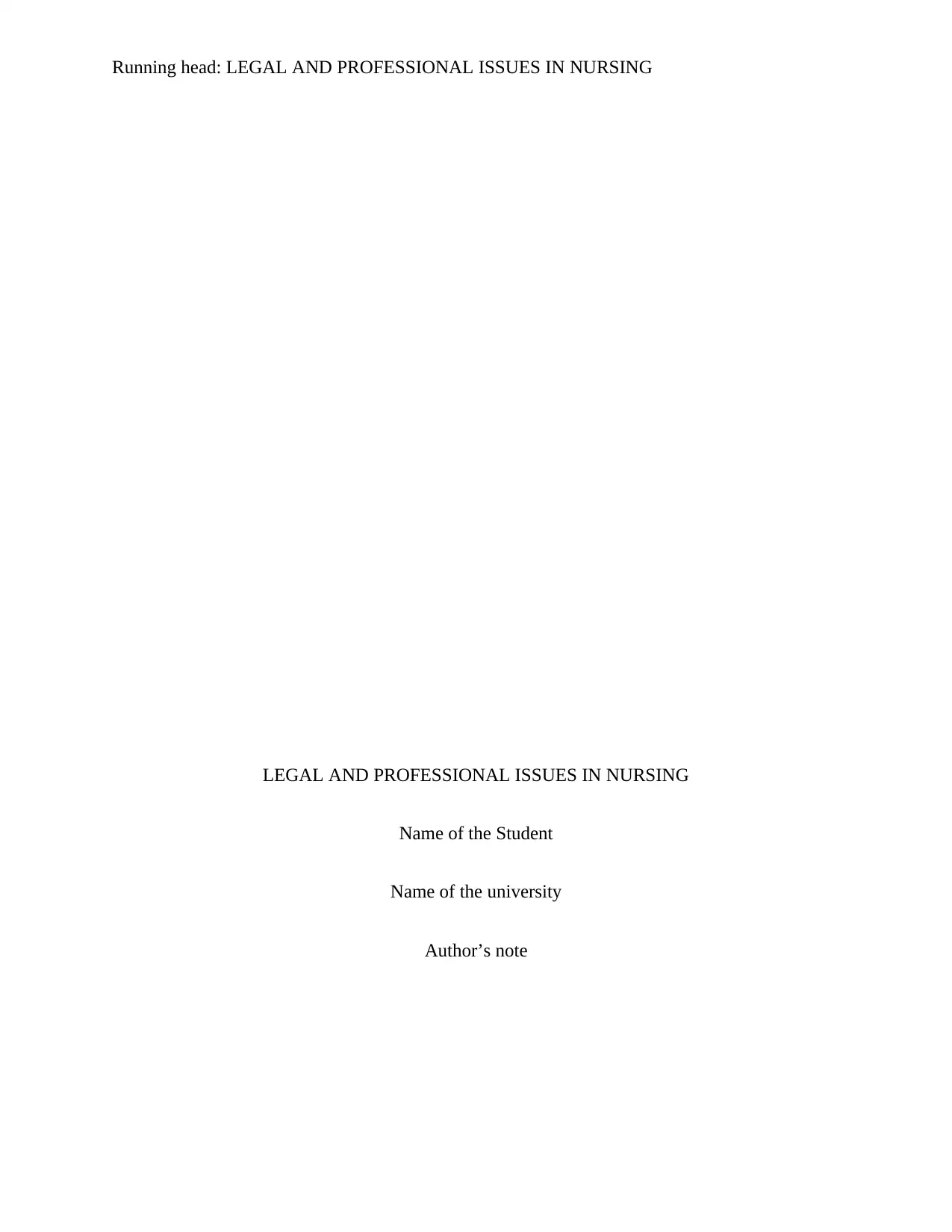
Running head: LEGAL AND PROFESSIONAL ISSUES IN NURSING
LEGAL AND PROFESSIONAL ISSUES IN NURSING
Name of the Student
Name of the university
Author’s note
LEGAL AND PROFESSIONAL ISSUES IN NURSING
Name of the Student
Name of the university
Author’s note
Secure Best Marks with AI Grader
Need help grading? Try our AI Grader for instant feedback on your assignments.
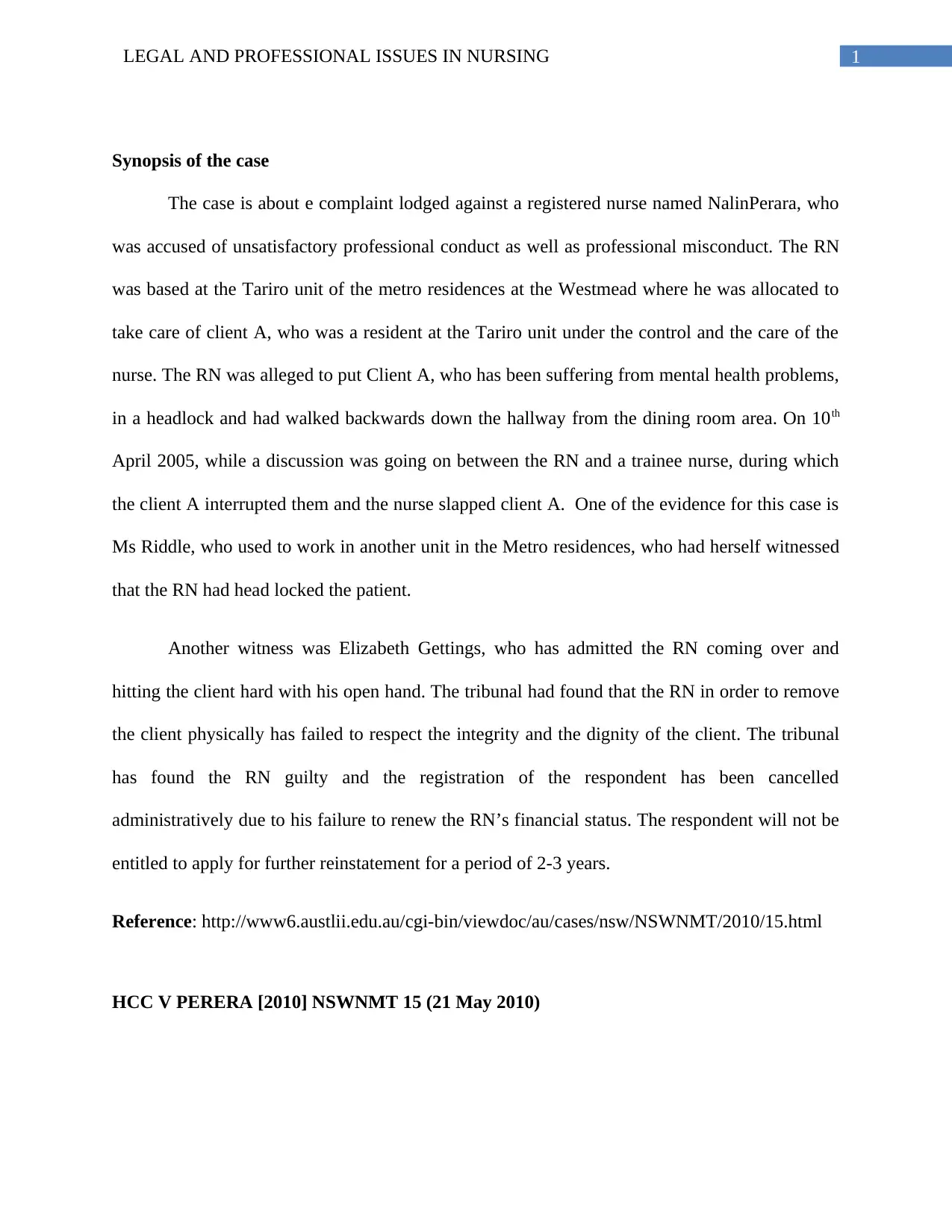
1LEGAL AND PROFESSIONAL ISSUES IN NURSING
Synopsis of the case
The case is about e complaint lodged against a registered nurse named NalinPerara, who
was accused of unsatisfactory professional conduct as well as professional misconduct. The RN
was based at the Tariro unit of the metro residences at the Westmead where he was allocated to
take care of client A, who was a resident at the Tariro unit under the control and the care of the
nurse. The RN was alleged to put Client A, who has been suffering from mental health problems,
in a headlock and had walked backwards down the hallway from the dining room area. On 10th
April 2005, while a discussion was going on between the RN and a trainee nurse, during which
the client A interrupted them and the nurse slapped client A. One of the evidence for this case is
Ms Riddle, who used to work in another unit in the Metro residences, who had herself witnessed
that the RN had head locked the patient.
Another witness was Elizabeth Gettings, who has admitted the RN coming over and
hitting the client hard with his open hand. The tribunal had found that the RN in order to remove
the client physically has failed to respect the integrity and the dignity of the client. The tribunal
has found the RN guilty and the registration of the respondent has been cancelled
administratively due to his failure to renew the RN’s financial status. The respondent will not be
entitled to apply for further reinstatement for a period of 2-3 years.
Reference: http://www6.austlii.edu.au/cgi-bin/viewdoc/au/cases/nsw/NSWNMT/2010/15.html
HCC V PERERA [2010] NSWNMT 15 (21 May 2010)
Synopsis of the case
The case is about e complaint lodged against a registered nurse named NalinPerara, who
was accused of unsatisfactory professional conduct as well as professional misconduct. The RN
was based at the Tariro unit of the metro residences at the Westmead where he was allocated to
take care of client A, who was a resident at the Tariro unit under the control and the care of the
nurse. The RN was alleged to put Client A, who has been suffering from mental health problems,
in a headlock and had walked backwards down the hallway from the dining room area. On 10th
April 2005, while a discussion was going on between the RN and a trainee nurse, during which
the client A interrupted them and the nurse slapped client A. One of the evidence for this case is
Ms Riddle, who used to work in another unit in the Metro residences, who had herself witnessed
that the RN had head locked the patient.
Another witness was Elizabeth Gettings, who has admitted the RN coming over and
hitting the client hard with his open hand. The tribunal had found that the RN in order to remove
the client physically has failed to respect the integrity and the dignity of the client. The tribunal
has found the RN guilty and the registration of the respondent has been cancelled
administratively due to his failure to renew the RN’s financial status. The respondent will not be
entitled to apply for further reinstatement for a period of 2-3 years.
Reference: http://www6.austlii.edu.au/cgi-bin/viewdoc/au/cases/nsw/NSWNMT/2010/15.html
HCC V PERERA [2010] NSWNMT 15 (21 May 2010)
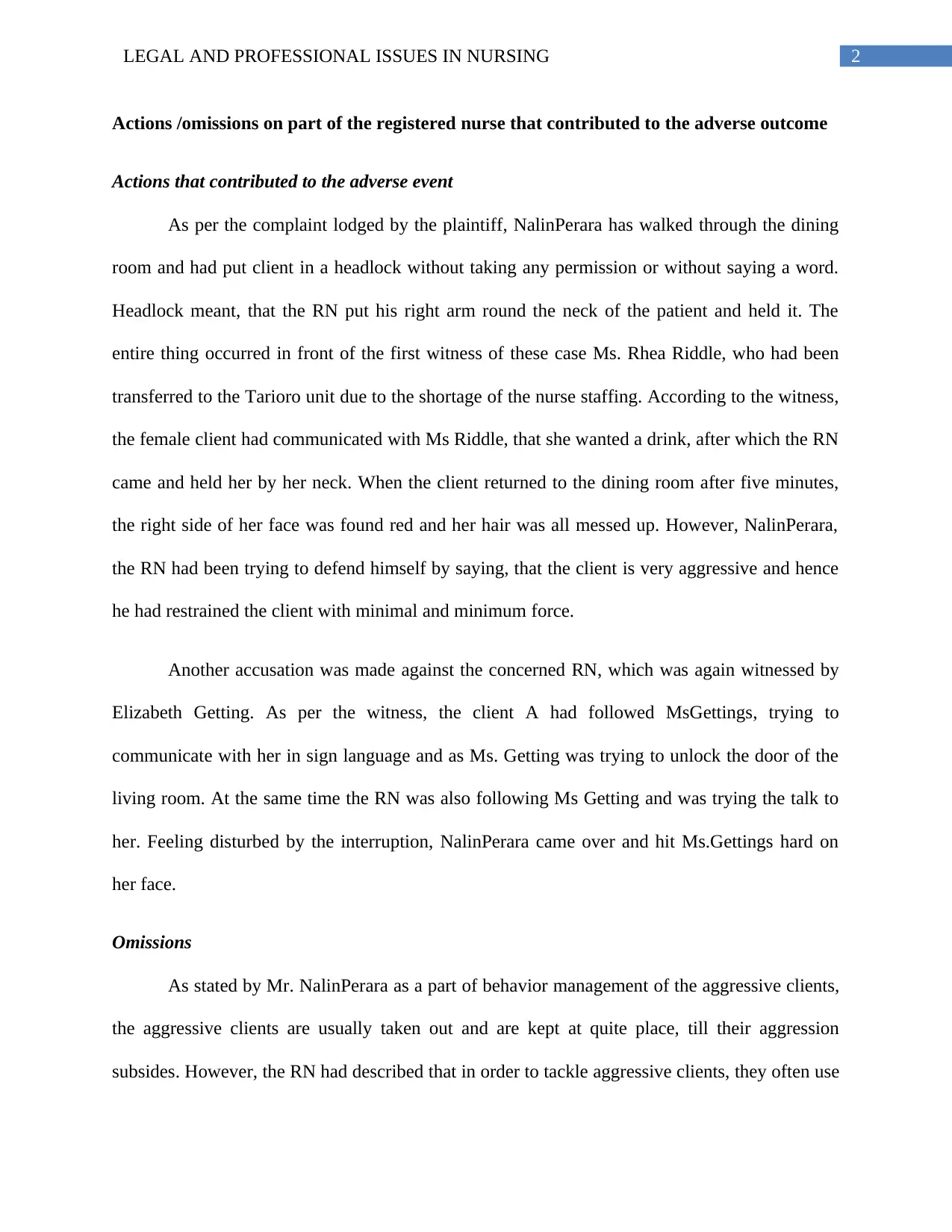
2LEGAL AND PROFESSIONAL ISSUES IN NURSING
Actions /omissions on part of the registered nurse that contributed to the adverse outcome
Actions that contributed to the adverse event
As per the complaint lodged by the plaintiff, NalinPerara has walked through the dining
room and had put client in a headlock without taking any permission or without saying a word.
Headlock meant, that the RN put his right arm round the neck of the patient and held it. The
entire thing occurred in front of the first witness of these case Ms. Rhea Riddle, who had been
transferred to the Tarioro unit due to the shortage of the nurse staffing. According to the witness,
the female client had communicated with Ms Riddle, that she wanted a drink, after which the RN
came and held her by her neck. When the client returned to the dining room after five minutes,
the right side of her face was found red and her hair was all messed up. However, NalinPerara,
the RN had been trying to defend himself by saying, that the client is very aggressive and hence
he had restrained the client with minimal and minimum force.
Another accusation was made against the concerned RN, which was again witnessed by
Elizabeth Getting. As per the witness, the client A had followed MsGettings, trying to
communicate with her in sign language and as Ms. Getting was trying to unlock the door of the
living room. At the same time the RN was also following Ms Getting and was trying the talk to
her. Feeling disturbed by the interruption, NalinPerara came over and hit Ms.Gettings hard on
her face.
Omissions
As stated by Mr. NalinPerara as a part of behavior management of the aggressive clients,
the aggressive clients are usually taken out and are kept at quite place, till their aggression
subsides. However, the RN had described that in order to tackle aggressive clients, they often use
Actions /omissions on part of the registered nurse that contributed to the adverse outcome
Actions that contributed to the adverse event
As per the complaint lodged by the plaintiff, NalinPerara has walked through the dining
room and had put client in a headlock without taking any permission or without saying a word.
Headlock meant, that the RN put his right arm round the neck of the patient and held it. The
entire thing occurred in front of the first witness of these case Ms. Rhea Riddle, who had been
transferred to the Tarioro unit due to the shortage of the nurse staffing. According to the witness,
the female client had communicated with Ms Riddle, that she wanted a drink, after which the RN
came and held her by her neck. When the client returned to the dining room after five minutes,
the right side of her face was found red and her hair was all messed up. However, NalinPerara,
the RN had been trying to defend himself by saying, that the client is very aggressive and hence
he had restrained the client with minimal and minimum force.
Another accusation was made against the concerned RN, which was again witnessed by
Elizabeth Getting. As per the witness, the client A had followed MsGettings, trying to
communicate with her in sign language and as Ms. Getting was trying to unlock the door of the
living room. At the same time the RN was also following Ms Getting and was trying the talk to
her. Feeling disturbed by the interruption, NalinPerara came over and hit Ms.Gettings hard on
her face.
Omissions
As stated by Mr. NalinPerara as a part of behavior management of the aggressive clients,
the aggressive clients are usually taken out and are kept at quite place, till their aggression
subsides. However, the RN had described that in order to tackle aggressive clients, they often use
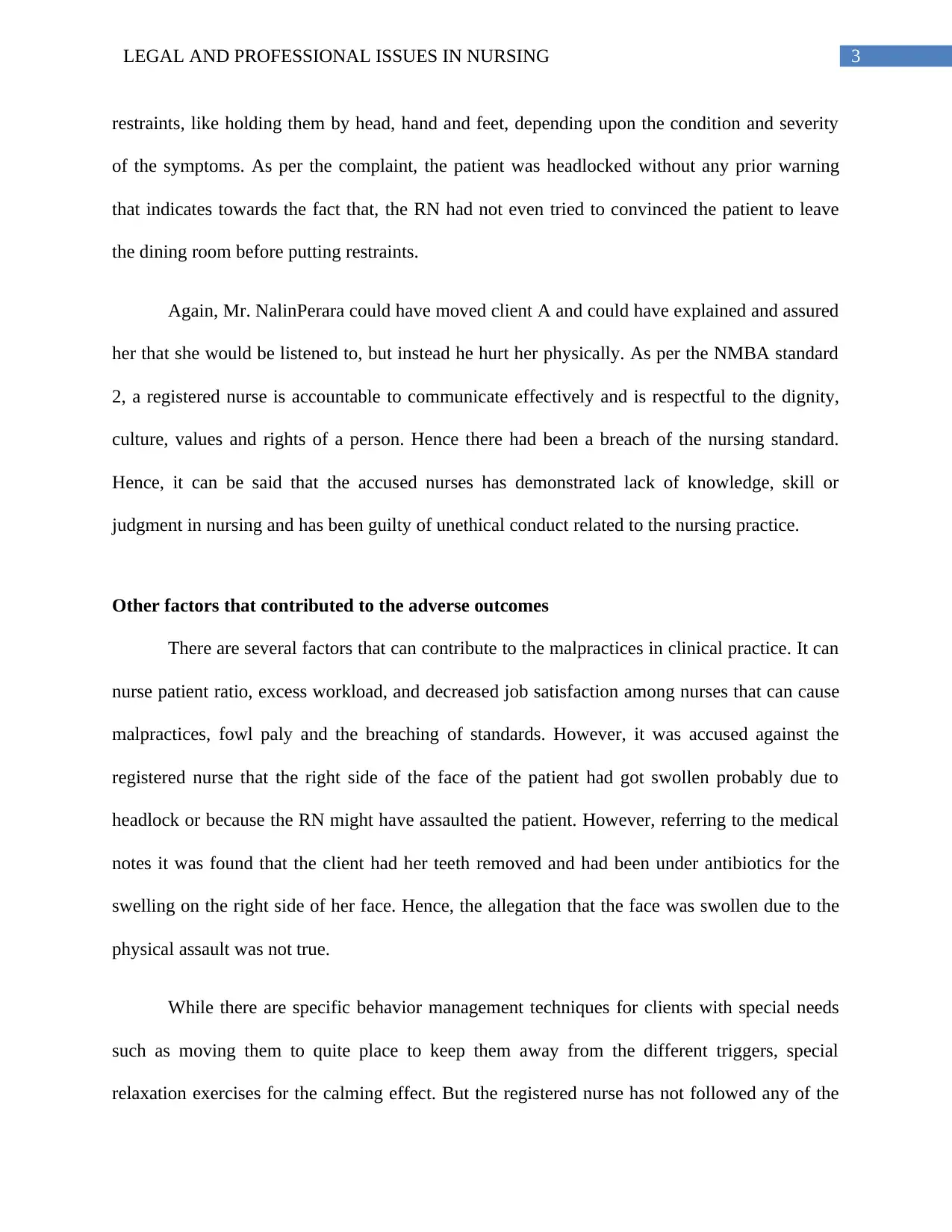
3LEGAL AND PROFESSIONAL ISSUES IN NURSING
restraints, like holding them by head, hand and feet, depending upon the condition and severity
of the symptoms. As per the complaint, the patient was headlocked without any prior warning
that indicates towards the fact that, the RN had not even tried to convinced the patient to leave
the dining room before putting restraints.
Again, Mr. NalinPerara could have moved client A and could have explained and assured
her that she would be listened to, but instead he hurt her physically. As per the NMBA standard
2, a registered nurse is accountable to communicate effectively and is respectful to the dignity,
culture, values and rights of a person. Hence there had been a breach of the nursing standard.
Hence, it can be said that the accused nurses has demonstrated lack of knowledge, skill or
judgment in nursing and has been guilty of unethical conduct related to the nursing practice.
Other factors that contributed to the adverse outcomes
There are several factors that can contribute to the malpractices in clinical practice. It can
nurse patient ratio, excess workload, and decreased job satisfaction among nurses that can cause
malpractices, fowl paly and the breaching of standards. However, it was accused against the
registered nurse that the right side of the face of the patient had got swollen probably due to
headlock or because the RN might have assaulted the patient. However, referring to the medical
notes it was found that the client had her teeth removed and had been under antibiotics for the
swelling on the right side of her face. Hence, the allegation that the face was swollen due to the
physical assault was not true.
While there are specific behavior management techniques for clients with special needs
such as moving them to quite place to keep them away from the different triggers, special
relaxation exercises for the calming effect. But the registered nurse has not followed any of the
restraints, like holding them by head, hand and feet, depending upon the condition and severity
of the symptoms. As per the complaint, the patient was headlocked without any prior warning
that indicates towards the fact that, the RN had not even tried to convinced the patient to leave
the dining room before putting restraints.
Again, Mr. NalinPerara could have moved client A and could have explained and assured
her that she would be listened to, but instead he hurt her physically. As per the NMBA standard
2, a registered nurse is accountable to communicate effectively and is respectful to the dignity,
culture, values and rights of a person. Hence there had been a breach of the nursing standard.
Hence, it can be said that the accused nurses has demonstrated lack of knowledge, skill or
judgment in nursing and has been guilty of unethical conduct related to the nursing practice.
Other factors that contributed to the adverse outcomes
There are several factors that can contribute to the malpractices in clinical practice. It can
nurse patient ratio, excess workload, and decreased job satisfaction among nurses that can cause
malpractices, fowl paly and the breaching of standards. However, it was accused against the
registered nurse that the right side of the face of the patient had got swollen probably due to
headlock or because the RN might have assaulted the patient. However, referring to the medical
notes it was found that the client had her teeth removed and had been under antibiotics for the
swelling on the right side of her face. Hence, the allegation that the face was swollen due to the
physical assault was not true.
While there are specific behavior management techniques for clients with special needs
such as moving them to quite place to keep them away from the different triggers, special
relaxation exercises for the calming effect. But the registered nurse has not followed any of the
Secure Best Marks with AI Grader
Need help grading? Try our AI Grader for instant feedback on your assignments.
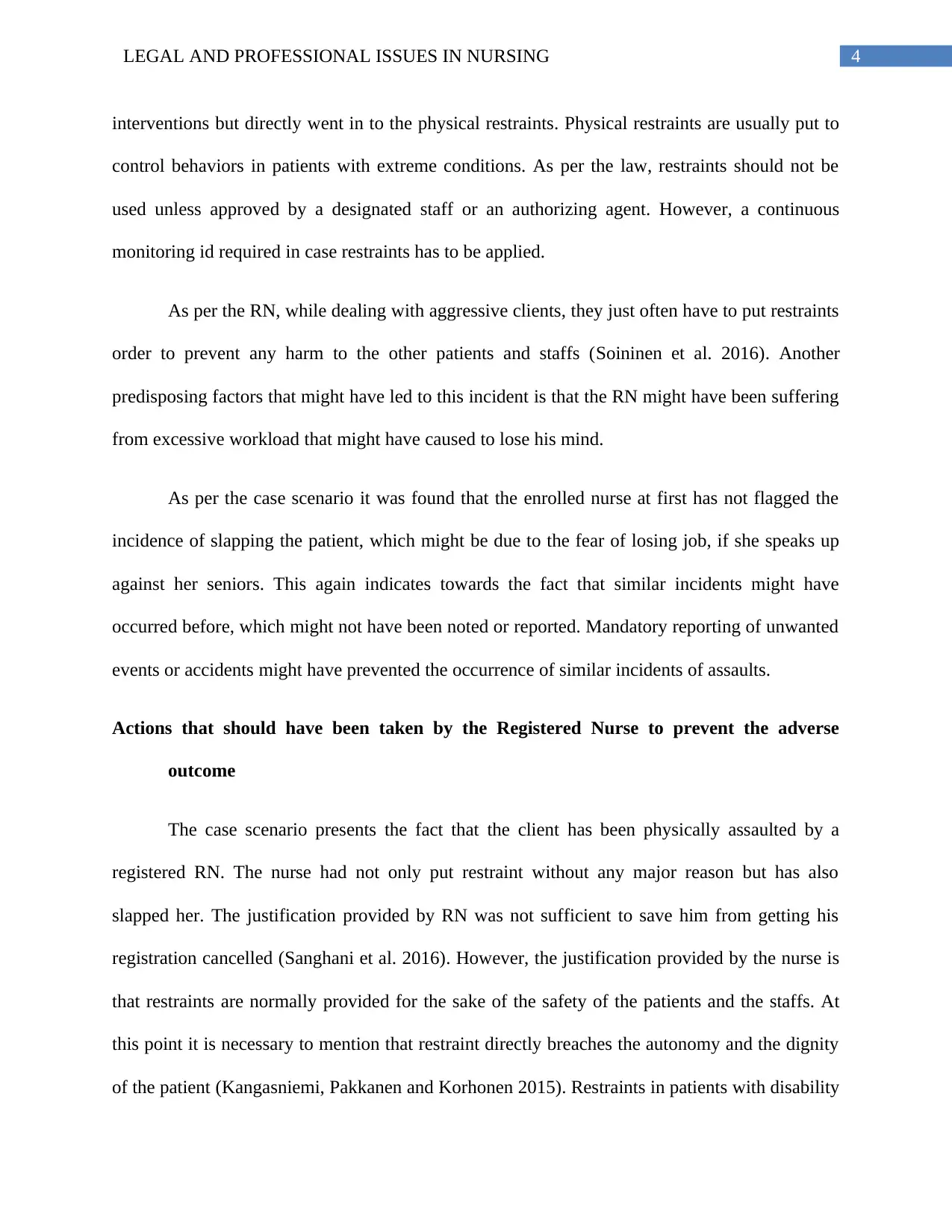
4LEGAL AND PROFESSIONAL ISSUES IN NURSING
interventions but directly went in to the physical restraints. Physical restraints are usually put to
control behaviors in patients with extreme conditions. As per the law, restraints should not be
used unless approved by a designated staff or an authorizing agent. However, a continuous
monitoring id required in case restraints has to be applied.
As per the RN, while dealing with aggressive clients, they just often have to put restraints
order to prevent any harm to the other patients and staffs (Soininen et al. 2016). Another
predisposing factors that might have led to this incident is that the RN might have been suffering
from excessive workload that might have caused to lose his mind.
As per the case scenario it was found that the enrolled nurse at first has not flagged the
incidence of slapping the patient, which might be due to the fear of losing job, if she speaks up
against her seniors. This again indicates towards the fact that similar incidents might have
occurred before, which might not have been noted or reported. Mandatory reporting of unwanted
events or accidents might have prevented the occurrence of similar incidents of assaults.
Actions that should have been taken by the Registered Nurse to prevent the adverse
outcome
The case scenario presents the fact that the client has been physically assaulted by a
registered RN. The nurse had not only put restraint without any major reason but has also
slapped her. The justification provided by RN was not sufficient to save him from getting his
registration cancelled (Sanghani et al. 2016). However, the justification provided by the nurse is
that restraints are normally provided for the sake of the safety of the patients and the staffs. At
this point it is necessary to mention that restraint directly breaches the autonomy and the dignity
of the patient (Kangasniemi, Pakkanen and Korhonen 2015). Restraints in patients with disability
interventions but directly went in to the physical restraints. Physical restraints are usually put to
control behaviors in patients with extreme conditions. As per the law, restraints should not be
used unless approved by a designated staff or an authorizing agent. However, a continuous
monitoring id required in case restraints has to be applied.
As per the RN, while dealing with aggressive clients, they just often have to put restraints
order to prevent any harm to the other patients and staffs (Soininen et al. 2016). Another
predisposing factors that might have led to this incident is that the RN might have been suffering
from excessive workload that might have caused to lose his mind.
As per the case scenario it was found that the enrolled nurse at first has not flagged the
incidence of slapping the patient, which might be due to the fear of losing job, if she speaks up
against her seniors. This again indicates towards the fact that similar incidents might have
occurred before, which might not have been noted or reported. Mandatory reporting of unwanted
events or accidents might have prevented the occurrence of similar incidents of assaults.
Actions that should have been taken by the Registered Nurse to prevent the adverse
outcome
The case scenario presents the fact that the client has been physically assaulted by a
registered RN. The nurse had not only put restraint without any major reason but has also
slapped her. The justification provided by RN was not sufficient to save him from getting his
registration cancelled (Sanghani et al. 2016). However, the justification provided by the nurse is
that restraints are normally provided for the sake of the safety of the patients and the staffs. At
this point it is necessary to mention that restraint directly breaches the autonomy and the dignity
of the patient (Kangasniemi, Pakkanen and Korhonen 2015). Restraints in patients with disability
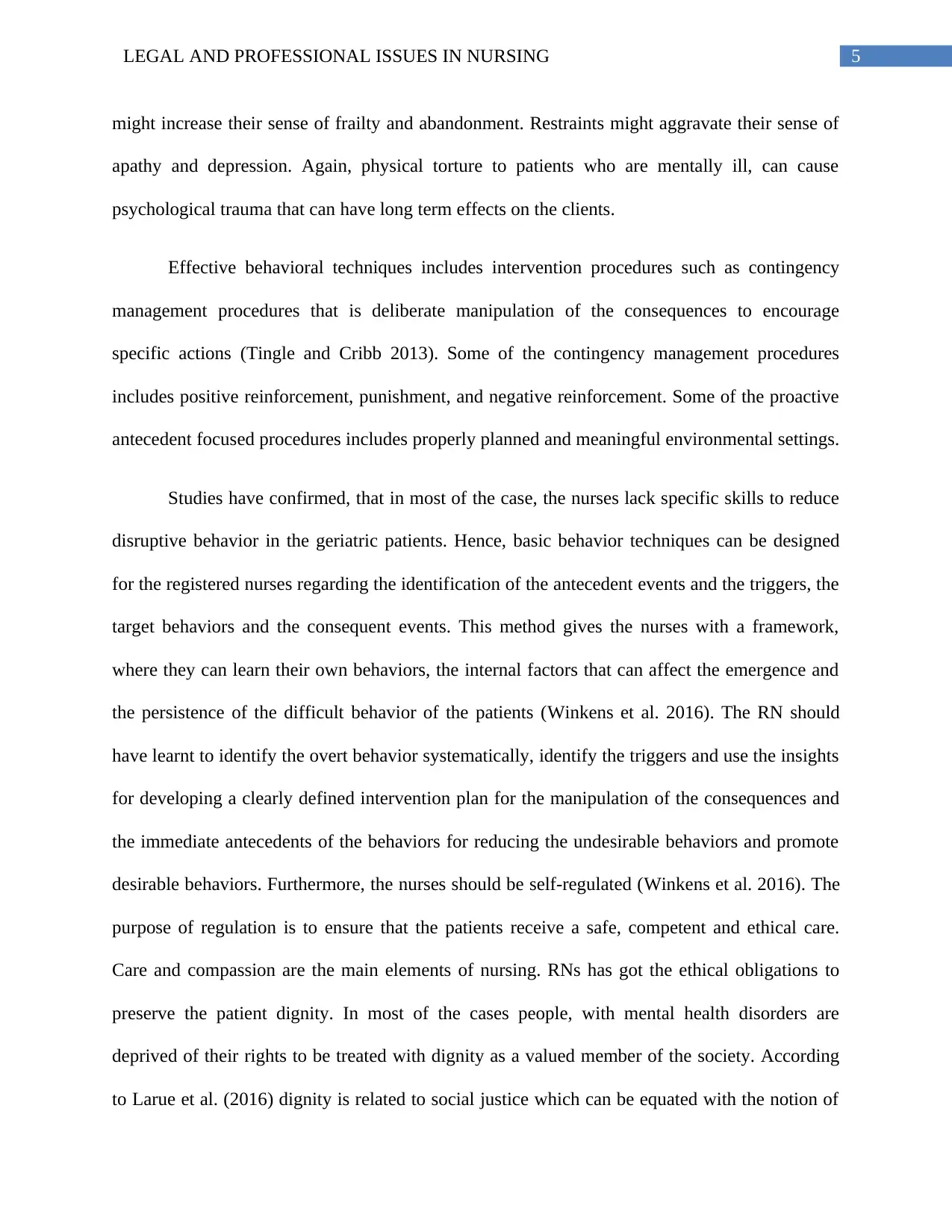
5LEGAL AND PROFESSIONAL ISSUES IN NURSING
might increase their sense of frailty and abandonment. Restraints might aggravate their sense of
apathy and depression. Again, physical torture to patients who are mentally ill, can cause
psychological trauma that can have long term effects on the clients.
Effective behavioral techniques includes intervention procedures such as contingency
management procedures that is deliberate manipulation of the consequences to encourage
specific actions (Tingle and Cribb 2013). Some of the contingency management procedures
includes positive reinforcement, punishment, and negative reinforcement. Some of the proactive
antecedent focused procedures includes properly planned and meaningful environmental settings.
Studies have confirmed, that in most of the case, the nurses lack specific skills to reduce
disruptive behavior in the geriatric patients. Hence, basic behavior techniques can be designed
for the registered nurses regarding the identification of the antecedent events and the triggers, the
target behaviors and the consequent events. This method gives the nurses with a framework,
where they can learn their own behaviors, the internal factors that can affect the emergence and
the persistence of the difficult behavior of the patients (Winkens et al. 2016). The RN should
have learnt to identify the overt behavior systematically, identify the triggers and use the insights
for developing a clearly defined intervention plan for the manipulation of the consequences and
the immediate antecedents of the behaviors for reducing the undesirable behaviors and promote
desirable behaviors. Furthermore, the nurses should be self-regulated (Winkens et al. 2016). The
purpose of regulation is to ensure that the patients receive a safe, competent and ethical care.
Care and compassion are the main elements of nursing. RNs has got the ethical obligations to
preserve the patient dignity. In most of the cases people, with mental health disorders are
deprived of their rights to be treated with dignity as a valued member of the society. According
to Larue et al. (2016) dignity is related to social justice which can be equated with the notion of
might increase their sense of frailty and abandonment. Restraints might aggravate their sense of
apathy and depression. Again, physical torture to patients who are mentally ill, can cause
psychological trauma that can have long term effects on the clients.
Effective behavioral techniques includes intervention procedures such as contingency
management procedures that is deliberate manipulation of the consequences to encourage
specific actions (Tingle and Cribb 2013). Some of the contingency management procedures
includes positive reinforcement, punishment, and negative reinforcement. Some of the proactive
antecedent focused procedures includes properly planned and meaningful environmental settings.
Studies have confirmed, that in most of the case, the nurses lack specific skills to reduce
disruptive behavior in the geriatric patients. Hence, basic behavior techniques can be designed
for the registered nurses regarding the identification of the antecedent events and the triggers, the
target behaviors and the consequent events. This method gives the nurses with a framework,
where they can learn their own behaviors, the internal factors that can affect the emergence and
the persistence of the difficult behavior of the patients (Winkens et al. 2016). The RN should
have learnt to identify the overt behavior systematically, identify the triggers and use the insights
for developing a clearly defined intervention plan for the manipulation of the consequences and
the immediate antecedents of the behaviors for reducing the undesirable behaviors and promote
desirable behaviors. Furthermore, the nurses should be self-regulated (Winkens et al. 2016). The
purpose of regulation is to ensure that the patients receive a safe, competent and ethical care.
Care and compassion are the main elements of nursing. RNs has got the ethical obligations to
preserve the patient dignity. In most of the cases people, with mental health disorders are
deprived of their rights to be treated with dignity as a valued member of the society. According
to Larue et al. (2016) dignity is related to social justice which can be equated with the notion of
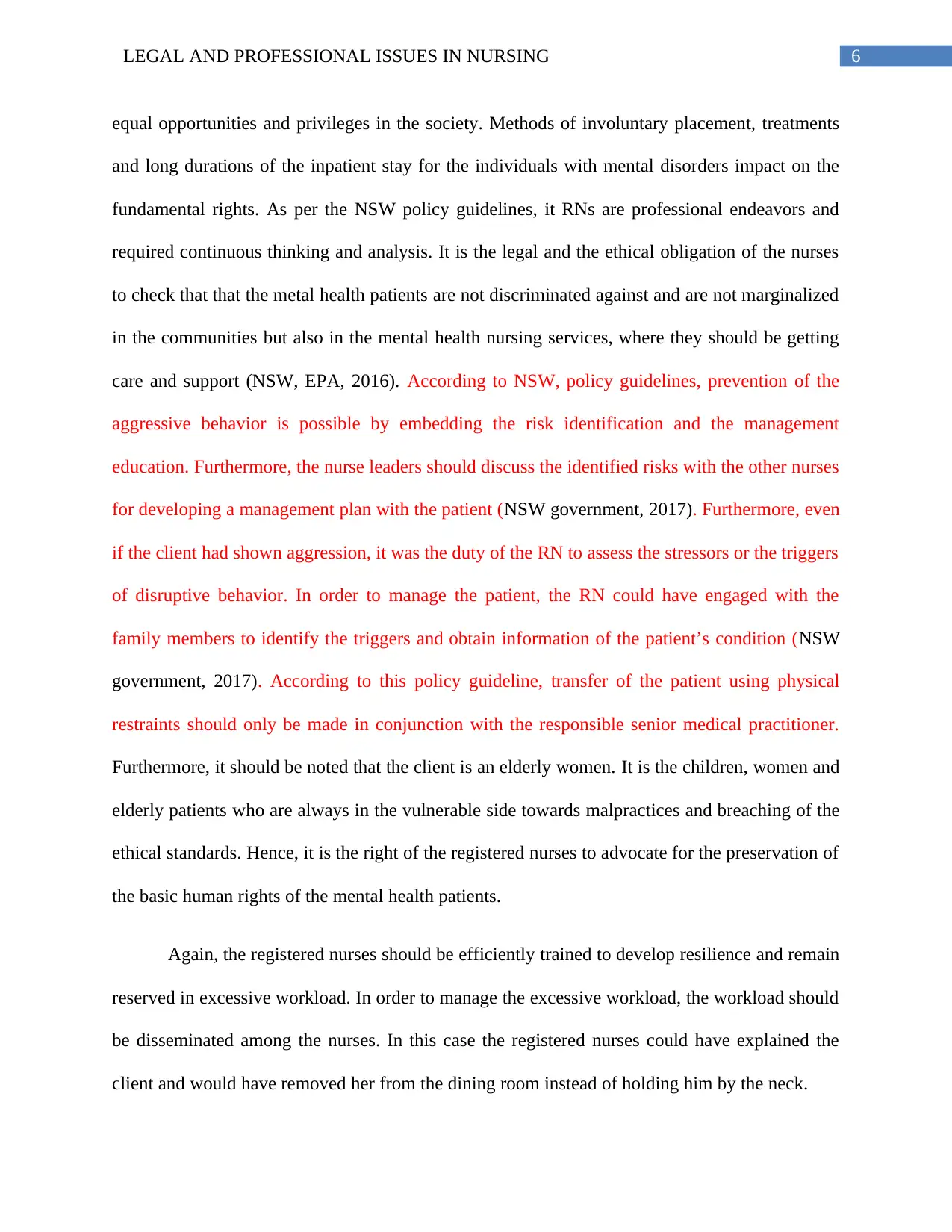
6LEGAL AND PROFESSIONAL ISSUES IN NURSING
equal opportunities and privileges in the society. Methods of involuntary placement, treatments
and long durations of the inpatient stay for the individuals with mental disorders impact on the
fundamental rights. As per the NSW policy guidelines, it RNs are professional endeavors and
required continuous thinking and analysis. It is the legal and the ethical obligation of the nurses
to check that that the metal health patients are not discriminated against and are not marginalized
in the communities but also in the mental health nursing services, where they should be getting
care and support (NSW, EPA, 2016). According to NSW, policy guidelines, prevention of the
aggressive behavior is possible by embedding the risk identification and the management
education. Furthermore, the nurse leaders should discuss the identified risks with the other nurses
for developing a management plan with the patient (NSW government, 2017). Furthermore, even
if the client had shown aggression, it was the duty of the RN to assess the stressors or the triggers
of disruptive behavior. In order to manage the patient, the RN could have engaged with the
family members to identify the triggers and obtain information of the patient’s condition (NSW
government, 2017). According to this policy guideline, transfer of the patient using physical
restraints should only be made in conjunction with the responsible senior medical practitioner.
Furthermore, it should be noted that the client is an elderly women. It is the children, women and
elderly patients who are always in the vulnerable side towards malpractices and breaching of the
ethical standards. Hence, it is the right of the registered nurses to advocate for the preservation of
the basic human rights of the mental health patients.
Again, the registered nurses should be efficiently trained to develop resilience and remain
reserved in excessive workload. In order to manage the excessive workload, the workload should
be disseminated among the nurses. In this case the registered nurses could have explained the
client and would have removed her from the dining room instead of holding him by the neck.
equal opportunities and privileges in the society. Methods of involuntary placement, treatments
and long durations of the inpatient stay for the individuals with mental disorders impact on the
fundamental rights. As per the NSW policy guidelines, it RNs are professional endeavors and
required continuous thinking and analysis. It is the legal and the ethical obligation of the nurses
to check that that the metal health patients are not discriminated against and are not marginalized
in the communities but also in the mental health nursing services, where they should be getting
care and support (NSW, EPA, 2016). According to NSW, policy guidelines, prevention of the
aggressive behavior is possible by embedding the risk identification and the management
education. Furthermore, the nurse leaders should discuss the identified risks with the other nurses
for developing a management plan with the patient (NSW government, 2017). Furthermore, even
if the client had shown aggression, it was the duty of the RN to assess the stressors or the triggers
of disruptive behavior. In order to manage the patient, the RN could have engaged with the
family members to identify the triggers and obtain information of the patient’s condition (NSW
government, 2017). According to this policy guideline, transfer of the patient using physical
restraints should only be made in conjunction with the responsible senior medical practitioner.
Furthermore, it should be noted that the client is an elderly women. It is the children, women and
elderly patients who are always in the vulnerable side towards malpractices and breaching of the
ethical standards. Hence, it is the right of the registered nurses to advocate for the preservation of
the basic human rights of the mental health patients.
Again, the registered nurses should be efficiently trained to develop resilience and remain
reserved in excessive workload. In order to manage the excessive workload, the workload should
be disseminated among the nurses. In this case the registered nurses could have explained the
client and would have removed her from the dining room instead of holding him by the neck.
Paraphrase This Document
Need a fresh take? Get an instant paraphrase of this document with our AI Paraphraser
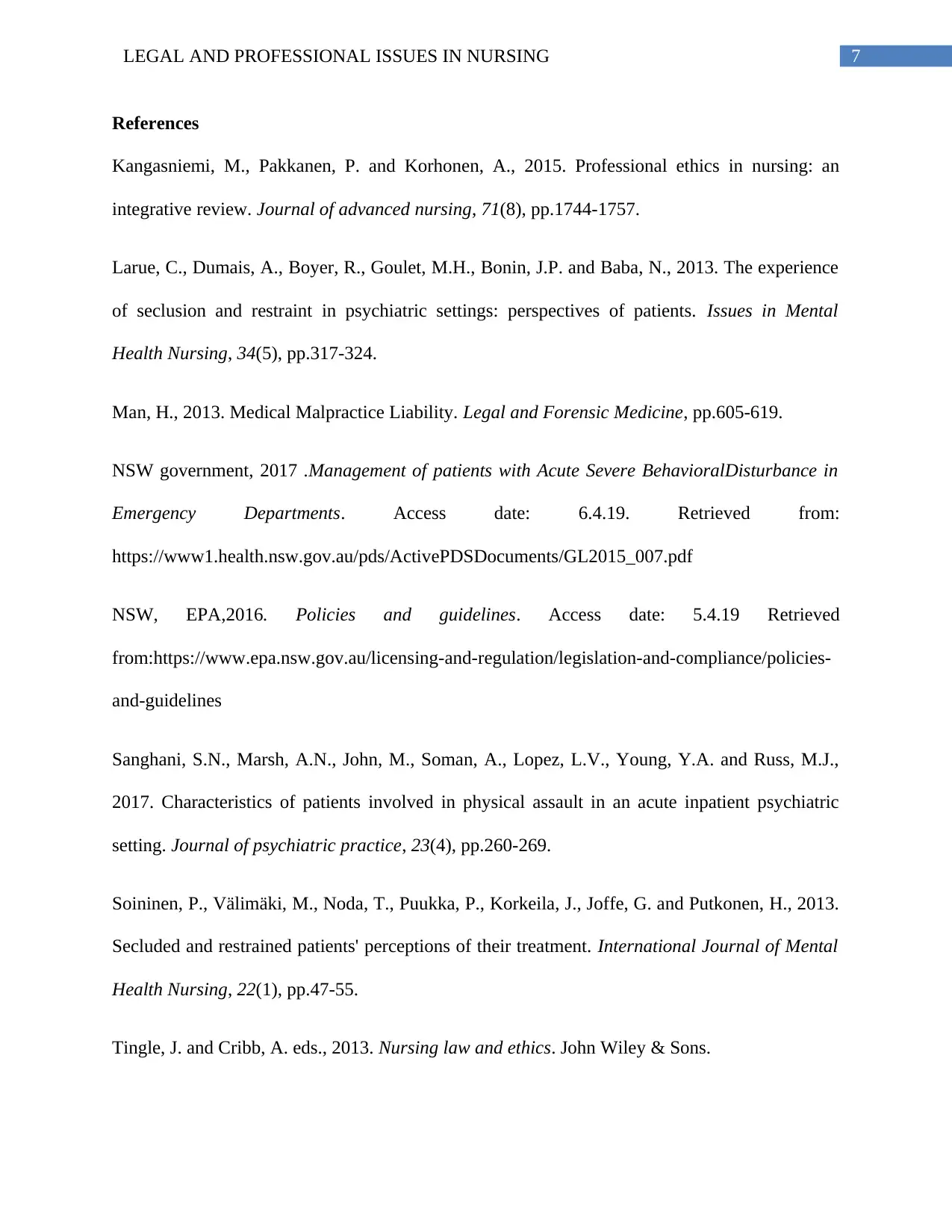
7LEGAL AND PROFESSIONAL ISSUES IN NURSING
References
Kangasniemi, M., Pakkanen, P. and Korhonen, A., 2015. Professional ethics in nursing: an
integrative review. Journal of advanced nursing, 71(8), pp.1744-1757.
Larue, C., Dumais, A., Boyer, R., Goulet, M.H., Bonin, J.P. and Baba, N., 2013. The experience
of seclusion and restraint in psychiatric settings: perspectives of patients. Issues in Mental
Health Nursing, 34(5), pp.317-324.
Man, H., 2013. Medical Malpractice Liability. Legal and Forensic Medicine, pp.605-619.
NSW government, 2017 .Management of patients with Acute Severe BehavioralDisturbance in
Emergency Departments. Access date: 6.4.19. Retrieved from:
https://www1.health.nsw.gov.au/pds/ActivePDSDocuments/GL2015_007.pdf
NSW, EPA,2016. Policies and guidelines. Access date: 5.4.19 Retrieved
from:https://www.epa.nsw.gov.au/licensing-and-regulation/legislation-and-compliance/policies-
and-guidelines
Sanghani, S.N., Marsh, A.N., John, M., Soman, A., Lopez, L.V., Young, Y.A. and Russ, M.J.,
2017. Characteristics of patients involved in physical assault in an acute inpatient psychiatric
setting. Journal of psychiatric practice, 23(4), pp.260-269.
Soininen, P., Välimäki, M., Noda, T., Puukka, P., Korkeila, J., Joffe, G. and Putkonen, H., 2013.
Secluded and restrained patients' perceptions of their treatment. International Journal of Mental
Health Nursing, 22(1), pp.47-55.
Tingle, J. and Cribb, A. eds., 2013. Nursing law and ethics. John Wiley & Sons.
References
Kangasniemi, M., Pakkanen, P. and Korhonen, A., 2015. Professional ethics in nursing: an
integrative review. Journal of advanced nursing, 71(8), pp.1744-1757.
Larue, C., Dumais, A., Boyer, R., Goulet, M.H., Bonin, J.P. and Baba, N., 2013. The experience
of seclusion and restraint in psychiatric settings: perspectives of patients. Issues in Mental
Health Nursing, 34(5), pp.317-324.
Man, H., 2013. Medical Malpractice Liability. Legal and Forensic Medicine, pp.605-619.
NSW government, 2017 .Management of patients with Acute Severe BehavioralDisturbance in
Emergency Departments. Access date: 6.4.19. Retrieved from:
https://www1.health.nsw.gov.au/pds/ActivePDSDocuments/GL2015_007.pdf
NSW, EPA,2016. Policies and guidelines. Access date: 5.4.19 Retrieved
from:https://www.epa.nsw.gov.au/licensing-and-regulation/legislation-and-compliance/policies-
and-guidelines
Sanghani, S.N., Marsh, A.N., John, M., Soman, A., Lopez, L.V., Young, Y.A. and Russ, M.J.,
2017. Characteristics of patients involved in physical assault in an acute inpatient psychiatric
setting. Journal of psychiatric practice, 23(4), pp.260-269.
Soininen, P., Välimäki, M., Noda, T., Puukka, P., Korkeila, J., Joffe, G. and Putkonen, H., 2013.
Secluded and restrained patients' perceptions of their treatment. International Journal of Mental
Health Nursing, 22(1), pp.47-55.
Tingle, J. and Cribb, A. eds., 2013. Nursing law and ethics. John Wiley & Sons.
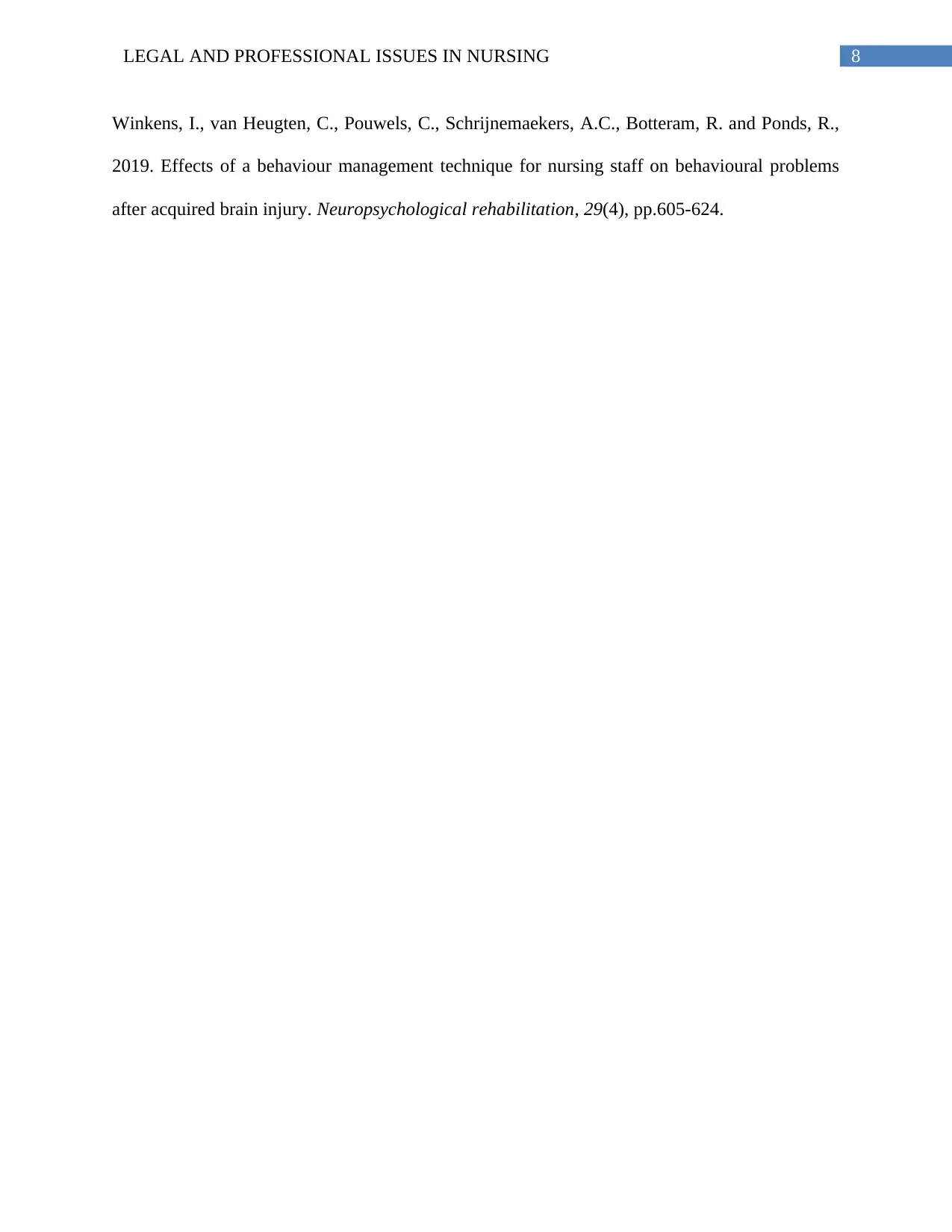
8LEGAL AND PROFESSIONAL ISSUES IN NURSING
Winkens, I., van Heugten, C., Pouwels, C., Schrijnemaekers, A.C., Botteram, R. and Ponds, R.,
2019. Effects of a behaviour management technique for nursing staff on behavioural problems
after acquired brain injury. Neuropsychological rehabilitation, 29(4), pp.605-624.
Winkens, I., van Heugten, C., Pouwels, C., Schrijnemaekers, A.C., Botteram, R. and Ponds, R.,
2019. Effects of a behaviour management technique for nursing staff on behavioural problems
after acquired brain injury. Neuropsychological rehabilitation, 29(4), pp.605-624.
1 out of 9
Your All-in-One AI-Powered Toolkit for Academic Success.
+13062052269
info@desklib.com
Available 24*7 on WhatsApp / Email
![[object Object]](/_next/static/media/star-bottom.7253800d.svg)
Unlock your academic potential
© 2024 | Zucol Services PVT LTD | All rights reserved.